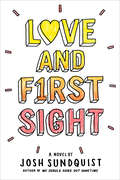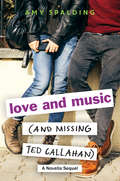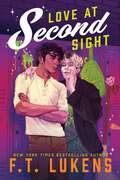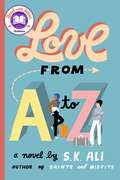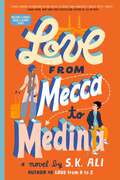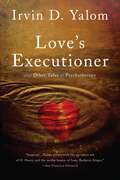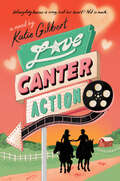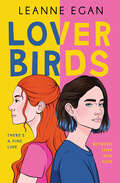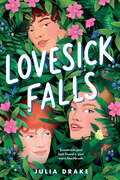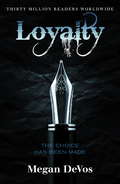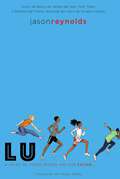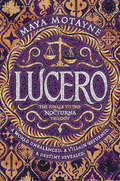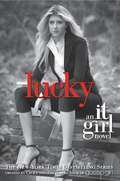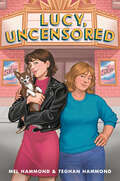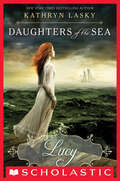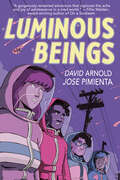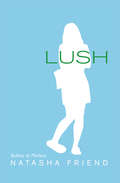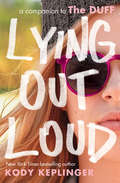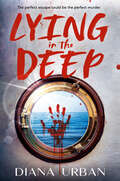- Table View
- List View
Love Your Amazing Self: Joyful Verses for Young Voices
by Ofosu Jones-QuarteyThis original, brightly illustrated collection of self-affirming lyrical meditations for kids ages 7 and up from Ofosu Jones-Quartey, a meditation teacher and recording artist, celebrates joy, resilience, empowerment, and self-compassion.
Love and First Sight
by Josh Sundquist<P> In his debut novel, YouTube personality and author of We Should Hang Out Sometime Josh Sundquist explores the nature of love, trust, and romantic attraction. <P>On his first day at a new school, blind sixteen-year-old Will Porter accidentally groped a girl on the stairs, sat on another student in the cafeteria, and somehow drove a classmate to tears. High school can only go up from here, right? As Will starts to find his footing, he develops a crush on a charming, quiet girl named Cecily. <P>Then an unprecedented opportunity arises: an experimental surgery that could give Will eyesight for the first time in his life. But learning to see is more difficult than Will ever imagined, and he soon discovers that the sighted world has been keeping secrets. <P>It turns out Cecily doesn't meet traditional definitions of beauty--in fact, everything he'd heard about her appearance was a lie engineered by their so-called friends to get the two of them together. Does it matter what Cecily looks like? No, not really. But then why does Will feel so betrayed? <P>Told with humor and breathtaking poignancy, Love and First Sight is a story about how we related to each other and the world around us.
Love and Music (and Missing Ted Callahan): A Novella Sequel
by Amy SpaldingA hilarious and romantic novella sequel to Kissing Ted Callahan (and Other Guys).This is it. This is the day Riley Jean Crowe-Ellerman officially becomes a ROCK STAR. It's summer, school's out, and Riley's band The Gold Diggers is playing their first music festival halfway across the country. It's the most exciting day ever, except for one small detail: Riley's boyfriend Ted is away at a Young Leaders summer program and can't be there to witness this momentous occasion. Riley hasn't seen Ted in three whole weeks--she misses his perfectly floppy hair, his kissable lips--and when he sends her a cryptic text that just says, "I'm so sorry," Riley starts to get nervous. TED! WHAT ARE YOU SORRY FOR?! But there's no response.Suddenly the best day of Riley's life might become the worst. Is this the end of Riley and Ted Callahan? Or can love and music keep them together?Word Count: ~12,000
Love at Second Sight
by F.T. LukensWhen a teen has an unexpected vision about a future murder, he must juggle newfound interest from the supernatural community with trying to prevent the murder from happening in this &“riveting&” (Publishers Weekly, starred review) New York Times bestselling romantic fantasy from F.T. Lukens.Fifteen-year-old Cam Reynolds wants to spend his sophomore year flying under the radar. That shouldn&’t be too hard, considering he&’s a human going to school with kids who have paranormal powers, like his best friend and witch, Al, and his longtime werewolf crush, Mateo. Then Cam has a psychic glimpse of the future in front of most of the student body, seeing a gruesomely murdered teen girl from the point of view of the killer. When Cam comes to, he knows two things: someone he goes to school with is a future murderer, and his life is about to change. No longer a mere human but a clairvoyant, one of the rarest of supernatural beings, Cam finds himself at the center of attention for the first time. As the most powerful supernatural factions in the city court Cam and his gift, he&’ll have to work with his friends, both old and new, to figure out who he can trust and who might be a werewolf in sheep&’s clothing. Because the clock is ticking, and Cam and his friends must identify the girl in the vision, find her potential killer, and prevent the murder from happening. Or the next murder Cam sees might be his own.
Love from A to Z
by S. K. Ali&“The bighearted, wildly charming, painfully real love story I&’ve been waiting for.&” —Becky Albertalli, New York Times bestselling author of Simon vs. the Homo Sapiens Agenda &“Heartfelt and powerful.&” —Kirkus Reviews (starred review) From William C. Morris Award Finalist S.K. Ali comes an unforgettable romance that is The Sun Is Also a Star meets Anna and the French Kiss, following two Muslim teens who meet during a spring break trip.A marvel: something you find amazing. Even ordinary-amazing. Like potatoes—because they make French fries happen. Like the perfect fries Adam and his mom used to make together. An oddity: whatever gives you pause. Like the fact that there are hateful people in the world. Like Zayneb&’s teacher, who won&’t stop reminding the class how &“bad&” Muslims are. But Zayneb, the only Muslim in class, isn&’t bad. She&’s angry. When she gets suspended for confronting her teacher, and he begins investigating her activist friends, Zayneb heads to her aunt&’s house in Doha, Qatar, for an early start to spring break. Fueled by the guilt of getting her friends in trouble, she resolves to try out a newer, &“nicer&” version of herself in a place where no one knows her. Then her path crosses with Adam&’s. Since he got diagnosed with multiple sclerosis in November, Adam&’s stopped going to classes, intent, instead, on perfecting the making of things. Intent on keeping the memory of his mom alive for his little sister. Adam&’s also intent on keeping his diagnosis a secret from his grieving father. Alone, Adam and Zayneb are playing roles for others, keeping their real thoughts locked away in their journals. Until a marvel and an oddity occurs… Marvel: Adam and Zayneb meeting. Oddity: Adam and Zayneb meeting.
Love from Mecca to Medina
by S. K. AliOn the trip of a lifetime, Adam and Zayneb must find their way back to each other in this surprising and romantic sequel to the &“bighearted, wildly charming&” (Becky Albertalli, New York Times bestselling author) Love from A to Z that&’s a &“contemplative exploration of faith, love, and the human condition&” (Kirkus Reviews, starred review).Adam and Zayneb. Perfectly matched. Painfully apart. Adam is in Doha, Qatar, making a map of the Hijra, a historic migration from Mecca to Medina, and worried about where his next paycheck will come from. Zayneb is in Chicago, where school and extracurricular stresses are piling on top of a terrible frenemy situation, making her miserable. Then a marvel occurs: Adam and Zayneb get the chance to spend Thanksgiving week on the Umrah, a pilgrimage to Mecca and Medina, in Saudi Arabia. Adam is thrilled; it&’s the reboot he needs and an opportunity to pray for a hijra in real life: to migrate to Zayneb in Chicago. Zayneb balks at the trip at first, having envisioned another kind of vacation, but then decides a spiritual reset is calling her name too. And they can&’t wait to see each other—surely, this is just what they both need. But the trip is nothing like what they expect, from the appearance of Adam&’s former love interest in their traveling group to the anxiety gripping Zayneb when she&’s supposed to be &“spiritual.&” As one wedge after another drives them apart while they make their way through rites in the holy city, Adam and Zayneb start to wonder: was their meeting just an oddity after all? Or can their love transcend everything else like the greatest marvels of the world?
Love in Winter Wonderland: A Feel-good Romance Guaranteed To Warm Hearts This Christmas!
by Abiola BelloThe Sun Is Also a Star meets You&’ve Got Mail in this YA Christmas love story set in a London Black-owned bookshop.Charming, handsome Trey Anderson balances the pressures of school popularity with a job at his family&’s beloved local bookshop, Wonderland.Quirky, creative Ariel Spencer needs tuition for the prestigious art program of her dreams, and an opening at Wonderland is the answer. When Trey and Ariel learn that Wonderland is on the brink of being shut down by a neighborhood gentrifier, they team up to stop the doors from closing before the Christmas Eve deadline—and embark on a hate-to-love journey that will change them forever.Heartwarming and romantic, this read is the gift that keeps on giving, no matter the season.
Love in the Time of Hate: In the Mirror of Urdu
by Dr Rakhshanda JalilKabhi hum bhi tum bhi thhe aashna tumhein yaad ho ke na yaad ho Once you and I were friends, whether you remember it now or not--Momin Khan Momin This is a book about love—love for one&’s country and for all that goes to make it one we can be proud to belong to. Poetry, it has been said, flourishes when all else is uncertain. With that in mind, renowned literary historian and translator, Rakhshanda Jalil, uses Urdu poetry to look at how the social fabric of secular India is changing. Rakhshanda delves into the past, to the events that have threatened communal harmony, from the bloodletting of partition, or the politics of successive elections, to communal riots, Mumbai, Gujarat and so on, to the present moment, to recent events around Ayodhya, cow slaughter and &‘love jihad&’. The book is divided into four sections: politics, people, passions, places. Strewn with delightful, thoughtful Urdu couplets that bring depth, lyricism and gravitas to the narratives, the writer cautions us against current popular sentiments based on hating the &‘other&’. Living in an India that now requires us to be resolutely one or the &‘other&’, all of us are losing the wonderful capacity to contain within ourselves many seemingly diverse ideologies and beliefs which is a motif that is reiterated through the verses and words in this book. The section titled &‘People&’ has the most delightful, charming vignettes of popular icons, from Tipu Sultan and Rani Lakshmi Bai to Gandhi and Nehru, from Ghalib and Majaz to Dilip Kumar and Lata Mangeshkar, viewed through an Urdu lens that makes each person memorable, unique and an advocate of peace and unity. From essays doused in the language of secular patriotism like Har Dil Tiranga, to pieces redolent with nostalgia like Dopahar ki Dhoop Mein, Rakhshanda invokes the power of love, inclusivity and communal harmony that is the trademark of poetry and literature, and which must continue to permeate the way we live our lives if we want to bequeath a meaningful legacy to the generations to come in our country.
Love's Executioner: & Other Tales of Psychotherapy
by Irvin D. YalomThe collection of ten absorbing tales by master psychotherapist Irvin D. Yalom uncovers the mysteries, frustrations, pathos, and humor at the heart of the therapeutic encounter. In recounting his patients' dilemmas, Yalom not only gives us a rare and enthralling glimpse into their personal desires and motivations but also tells us his own story as he struggles to reconcile his all-too human responses with his sensibility as a psychiatrist. Not since Freud has an author done so much to clarify what goes on between a psychotherapist and a patient.
Love, Canter, Action
by Katie GilbertSaddle up for this swoony enemies-to-lovers romance, full of giggles, snark, and heart, perfect for fans of Kasie West and Emma Lord. Nora Green wants out. Out of rural Georgia—and, more importantly, out of the house she&’s been resentfully occupying with her father and his wife. It&’s been five months since her mama died and the state dumped her on her father&’s doorstep, and Nora&’s been counting every second. With the sudden closure of the Shep horse ranch, Nora&’s last home-away-from-home, comes two surprises: news of her admission to a prestigious equine training program in Montana, and a job wrangling horses on a movie set to cover the costs. To her eternal nightmare, she discovers that the movie stars teen heartthrob Alexander Mathis, hot off the heels of a very public scandal. Not that Nora cares who he is—to her, he&’s just the obnoxious stranger who interrupted her dinner the night before. When photos of their argument are misread as a passionate affair, the Internet falls head-over-hooves for Hollywood&’s newest couple. Eager to capitalize on the press, Alec offers Nora a deal: go on three fake dates with him, and he&’ll cover her ticket to Montana. But the lines between script and reality have a way of blurring, and when the truth about Alec&’s scandal catches up to him, Nora has a choice: continue shutting everyone out, or open her heart to the love that&’s always been around her.
Love, Off the Record
by Samantha MarkumThe Hating Game meets Alex, Approximately in this smart, chemistry-filled teen rom-com about two rival journalism students competing for the same position on their university newspaper.Wyn is going to beat Three even if it kills her—or, preferably, him. Being freshmen staffers on the university newspaper puts them at the bottom of the pecking order—until a rare reporter spot opens up. Wyn and Three are both determined to get the position, starting a game of sabotage that pushes them to do their worst, from stealing each other&’s ideas to playing twisted mind games. No road is too low when it comes to winning. As Wyn&’s search for the perfect story leads her to an anonymous, campus-wide dating app, she hits it off with a mystery man she thinks might be the cute RA from her dorm. But Wyn is all too familiar with being rejected because of her weight, and she&’s hesitant to reveal her identity, even as she grows closer with someone who might be the guy of her dreams. When Three breaks a story that&’s closer to home than he or Wyn expects, the two must put aside their differences to expose the truth—and face their real feelings for each other, which threaten everything Wyn has built with her anonymous match.
Loveboat Forever (Loveboat)
by Abigail Hing WenReturn to the sparkling world of Loveboat, this time with Pearl Wong, on an entirely new, romantic, whirlwind adventure from Abigail Hing Wen, New York Times bestselling author of Loveboat, Taipei, streaming now on Paramount+ (adaptation titled Love in Taipei). Pearl was ready for a worldwide stage. Instead, she needs to stage a comeback.Seventeen-year-old music prodigy Pearl Wong had the summer of her dreams planned—until a fall from grace leaves her in need of new plans…and a new image.Where better to revamp her “brand” than at Chien Tan, the Taipei summer program for elite students that rocketed her older sister, Ever, on a path to romance and self-fulfillment years ago.But as the alumni know, Chien Tan is actually Loveboat—the extravagant world where prodigies party till dawn—and there’s more awaiting Pearl there than she could have ever imagined, like a scandalous party in the dark, a romantic entanglement with a mysterious suitor...and a summer that will change her forever.Sweeping, glamorous, and deeply soulful, this companion to the New York Times bestselling novel Loveboat, Taipei and Loveboat Reunion will reunite readers with their favorite characters, in a thrilling new journey of romance, self-discovery, and empowerment. Perfect for fans of Jenny Han and Sarah Dessen. "What a sheer delight it is to be back in Taipei, this time as classical musician Pearl Wong recovers from social media catastrophe at the same summer program that so radically transformed her sister, Ever. Full of familiar faces and new friends, revelry, romance, and self-discovery, Abigail Hing Wen has crafted another confection you’ll want to devour in a single sitting." —Gayle Forman, #1 New York Times bestselling author of If I Stay"What a fun romance with breathtaking destinations, hilarious mishaps, and heartwarming surprises. Another winner in Abigail Hing Wen’s enchanting Loveboat book series!" —Melissa de la Cruz, #1 New York Times bestselling author
Lover Birds
by Leanne EganA fantastic, queer enemies-to-lovers story -- in one corner, a girl with ADHD experiencing her first girl crush in a monumental way; in the other corner, a posh, rich girl who's new to school and has her own reasons to be guarded. Told with humor and heart, this is a perfect novel for Alice Oseman and Becky Albertalli fans, and marks a great new YA romcom voice.Darci catches Elle's eye the minute she arrives as the new girl in school. But Elle keeps her curiosity in check, and even seems dismissive (which Darci overhears). Then Darci is equally dismissive (which Elle overhears)... and immediately a rivalry is born. Things become knottier when Darci is asked to be Elle's tutor, and even knottier than that when Elle starts to recognize her feeling as something other than disdain or derision. In fact, it might be... the opposite. There are many misunderstandings that need to be gotten past for Elle and Darci to figure out how perfect they are for each other.
Lovesick Falls
by Julia DrakeThis queer take on As You Like It features first loves, friend breakups and madcap mix-ups, from award-winning author Julia Drake. Celia Gilbert is the perfect friend—loyal, trustworthy, and committed to mending her best friends&’ broken hearts. She&’s the reason the trio is spending the summer in Lovesick Falls, the idyllic little town where Touchstone&’s sort-of-uncle&’s cabin was waiting to be house-sat by three unsupervised (but totally responsible) teenagers. After all, Celia, Ros, and Touchstone have been best friends since childhood. Sure, Celia is in love with Ros, and Touchstone was once in love with Celia — but that&’s the beauty of a place like Lovesick Falls. If you fell in love, you could fall out. Unless you can change the other person&’s mind. They started the summer closer than ever. Will living together tear them apart?
Loyalty: Book 2 in the Anarchy series (Anarchy Ser.)
by Megan DeVosTHIRTY MILLION READERS WORLDWIDE. INCLUDES EXCLUSIVE NEVER BEFORE SEEN CHAPTER.'The Hunger Games meets The Road' MTVDon't look back. That's where the danger lies.With Grace left reeling from choosing between Hayden and her family, she knows she needs to accept her decision. Meanwhile as the youngest leader of Blackwing, Hayden is coping with the demands placed on him to keep the camp alive. Can he protect his friends from their violent rivals? And should he trust himself to do the right thing?Demand loyalty. Protect your family. Trust no one.
Lu (Track #4)
by Jason ReynoldsLa última vuelta de la serie Atletismo del autor Jason Reynolds, finalista del National Book Award y autor best seller del New York Times, ¡ahora disponible en español!Fantasma. Lu. Patina. Sunny. Cuatro jóvenes de familias completamente diferentes, con personalidades que se vuelven explosivas al chocar. Pero son también cuatro jóvenes de secundaria que fueron escogidos para un equipo de élite de atletismo… un equipo que los podría ayudar a clasificar para las Olimpiadas Juveniles. Todos tienen mucho que perder, pero también tienen mucho que demostrar, no solo a sus compañeros sino a sí mismos. Lu es el prototípico atleta bonitillo con tenis a la moda, gafas de sol, etc. Es el tipo de chamaco al que idolatras o al que quieres DARLE UN PUÑETAZO. Corre la carrera más popular, los 400 metros, y tiene un talento descomunal. Participa en el atletismo desde pequeño; sus padres lo metieron en deportes para ayudarlo a ganar confianza en sí mismo porque es albino. Pero su plan produjo un efecto indeseado. El niño ganó tanta confianza que se ha vuelto más chulo que un ocho y un pavo real, y por eso es el chamaco que nunca ha tenido amigos de verdad. Ninguno. Además, su padre, que también comparte la afición de su hijo por ser fanfarrón, se ha visto envuelto en algún tipo de actividad ilegal. Pero los novatos del equipo (Fantasma, Patina y Sunny) no aguantan su pavoneo, pero tampoco lo evitan como lo hacen todos los demás. Le llaman la atención por sus tonterías, pero lo incluyen en las payasadas. ¿Serán los primeros chamacos en romper su coraza de autoconfianza y ver en él algo más que la capa de pavo real que oculta su falta de color?
Lucero (Nocturna #3)
by Maya MotayneThe thrilling finale to the #1 Sunday Times and Los Angeles Times bestselling Nocturna trilogy—a sweeping and epic Dominican-inspired fantasy about a face-changing thief and a risk-taking prince who must save their kingdom in the final battle between good and evil magic. Perfect for fans of Tomi Adeyemi, Sabaa Tahir, and Roseanne A. Brown.In the aftermath of Sombra’s return, the balance between light and dark magic has been destroyed and chaos has broken out in Castallan and around the world. Sombra’s shadows have taken over to create monstrous versions of everyone Finn and Alfie love, and with war between Castallan and Englass looming, the prince and the thief must band together one last time—to save their entire world.To stop the magical imbalance, they must find the stone relics of Sombra’s body before the god can unite the pieces and regain his full strength once more.But the laws of magic no longer apply, and with their own magic—and even the laws of time itself—drastically changing at every turn, Finn and Alfie are left on their own to stop Sombra and fulfill their prophecy before it is too late and the darkness reigns.Will they restore balance to their world or will its light be gone forever?
Lucky in Love (Point Ser.)
by Kasie WestIn this new contemporary from YA star Kasie West, a girl who wins the lottery learns that money can cause more problems than it solves, especially when love comes into the picture.Maddie's not impulsive. She's all about hard work and planning ahead. But one night, on a whim, she buys a lottery ticket. And then, to her astonishment --She wins!In a flash, Maddie's life is unrecognizable. No more stressing about college scholarships. Suddenly, she's talking about renting a yacht. And being in the spotlight at school is fun... until rumors start flying, and random people ask her for loans. Now, Maddie isn't sure who she can trust. Except for Seth Nguyen, her funny, charming coworker at the local zoo. Seth doesn't seem aware of Maddie's big news. And, for some reason, she doesn't want to tell him. But what will happen if he learns her secret? With tons of humor and heart, Kasie West delivers a million-dollar tale of winning, losing, and falling in love.
Lucky: An It Girl Novel (It Girl #5)
by Cecily Von ZiegesarJenny Humphrey has attended some crazy parties at Waverly Academy, but none as hot as the bash at Miller farm, where the barn went up in flames. Literally. So when Dean Marymount announces that someone is going to be expelled, it's every owl for him- and herself. Tensions are rising, rumors are flying, and pretty soon everyone is a suspect. Jenny is worried about her adorable, shaggy-haired new crush, Julian, whose lighter was found at the scene of the crime. Callie is afraid she and Easy will both get kicked out, because they were in the barn--together--when it caught fire. And Tinsley knows she'll take the heat for organizing the wild party in the first place. Luckily she's come up with a way to keep from getting in trouble: by blaming Jenny. Of course. After all, Waverly's girls always fight fire with fire. But watch out, ladies--in a battle like this, someone's bound to get burned.
Lucy, Uncensored
by Mel Hammond Teghan HammondA road trip through gender identity, self-expression, and the thorny process of figuring out where you fit after high school as an out-and-proud transgender teen.Lucy imagines college as more than a chance to party with other drama nerds and be roommates with her best friend Callie. College will be her fresh start. For the first time, she'll be able to introduce herself as Lucy to people she hasn't gone to school with since kindergarten. Plus, she happens to live an hour away from one of the most prestigious theater programs in the country. She's always dreamed of going to Central, but when she finally has a chance to visit, it's not what she imagined.While Lucy and Callie are on their campus tour, two kids from their high school make the typical transphobic comments Lucy's gotten used to in her small town. She starts to worry that her dream school might end up being High School 2.0. What if she belongs somewhere else? Somewhere that she can truly have a fresh start?When Lucy finds a beautiful school with a great theater program on a list of the most LGBTQ+ friendly colleges, it seems like fate—except that the school is hundreds of miles away. And there's something unexpected about it: it's a women's college. As far as she can tell, they've never admitted a trans woman. Will they let Lucy in? There&’s only one way to find out: road trip!
Lucy: Lucy (Daughters Of The Sea #3)
by Kathryn LaskyA choice between love and survival . . .Lucy's family is excited to spend the summer in Bar Harbor, Maine. Her minister father is pleased to preside over such a prestigious congregation, and his social-climbing wife is ecstatic at the chance to find a rich husband for her daughter. Yet Lucy wants nothing to do with the Bar Harbor social scene; she's simply excited to spend the summer by the sea, watching the waves from her favorite spot on the cliff. Despite having never gone swimming, Lucy feels an intense connection to the ocean, and meets a handsome ship-builder who shows Lucy a world she's never known, yet somehow always longed for. However, her mother will stop at nothing to keep Lucy and the ship builder apart, even if it means throwing Lucy into the arms of a wealthy man with a dangerous secret. Can Lucy break free and embrace her destiny as a daughter of the sea? Or is she doomed to waste away in a gilded cage, slowly dying of a broken heart?
Luminous Beings: A Graphic Novel
by David Arnold"A gorgeously rendered adventure that captures the ache and joy of adolescence in a mad world."--Tillie Walden, award-winning author of On a SunbeamTy and Burger have known each other since before they could walk. But this shared history is nothing compared to their plans for the future: step one, make a killer documentary about humanity&’s recent brush with extinction; step two, apply to film school together; step three, achieve legendary status as the next great filmmaking duo. But Ty has a secret that will ultimately shake the foundations of their friendship and force them both to wonder if growing up means letting go of the people they once were.With heads full of bioluminescence and hearts full of fury, &“squizzies&” have one thing on their tiny rodent brains: global annihilation. Their reign of terror may be a thing of the past, but Ty and Burger are determined to chronicle the perseverance of the human race in the wake of the &“squirrel-pocalypse.&” With friends Miles and Fib, they embark on an overnight excursion through rowdy nightclubs, once-familiar neighborhoods, perilous castles, and off-grid RVs, all the while, recording quiet lives of love and loss in a strange new world.Set over the course of a single day, Luminous Beings explores the many facets of friendship and love, the heavy burden of a well-kept secret, the boundless tenacity of the human spirit, and, yes, the furriest of all zombified mammals. But don&’t worry, it&’s not the end of the world. Just the end of the squirrel
Lush
by Natasha FriendNatasha Friend is a Judy Blume for today -- clearly evident in this remarkable new novel about a girl whose father is an alcoholic and how she and her family learn to deal with his condition.It's hard to be a 13-year-old girl. But it's even harder when your father's a drunk. It adds an extra layer to everything -- your family's reactions to things, the people you're willing to bring home, the way you see yourself and the world. For Samantha, it's something that's been going on for so long that she's almost used to it. Only, you never get used to it. Especially when it starts to get worse...
Lying Out Loud: A Companion to The DUFF
by Kody KeplingerA companion to Kody Keplinger's debut novel, THE DUFF!Sonny Ardmore is an excellent liar. She lies about her dad being in prison. She lies about her mom kicking her out. And she lies about sneaking into her best friend's house every night because she has nowhere else to go. Amy Rush might be the only person Sonny shares everything with -- secrets, clothes, even a nemesis named Ryder Cross. Ryder's the new kid at Hamilton High and everything Sonny and Amy can't stand -- a prep-school snob. But Ryder has a weakness: Amy. So when Ryder emails Amy asking her out, the friends see it as a prank opportunity not to be missed. But without meaning to, Sonny ends up talking to Ryder all night online. And to her horror, she realizes that she might actually like him. Only there's one small catch: He thinks he's been talking to Amy. So Sonny comes up with an elaborate scheme to help Ryder realize that she's the girl he's really wanted all along. Can Sonny lie her way to the truth, or will all her lies end up costing her both Ryder and Amy?
Lying in the Deep
by Diana UrbanA juicy thriller of jealousy, love, and betrayal set on a Semester at Sea-inspired cruise ship, with a diverse cast of delightfully suspicious characters who&’ll leave you guessing with every jaw-dropping twist.After being jilted by her ex-boyfriend and best friend, Jade couldn't be more ready to embark on the adventure of a lifetime—11 countries in 4 months, all from the luxurious Campus on Board ship—and to wedge an entire globe between her and the people who broke her heart.But when Jade discovers the backstabbing couple are also setting sail, her obsession with them grows and festers, leading to a shocking murder. And as their friends begin to drop like flies, Jade and her new crush must race to clear her name and find the killer they&’re trapped at sea with….before anyone else winds up in body bags.Perfect for readers of Natalie D. Richards, E. Lockhart, and Karen McManus!

